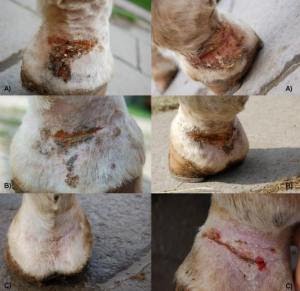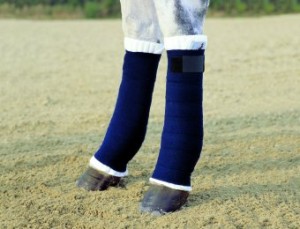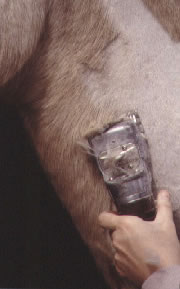Stable Management – Mud Fever

Mud fever is a terrible nuisance for me this summer. We have had lots of rain and the moist conditions that have hastened the development of mud fever.
For the uninitiated, mud fever is a painful red rash on the back of the horse’s pasterns and can even afflict the fetlocks. I have seen it mostly on the white legs and the pasterns of the legs with white hooves. Left untreated this rash will develop into painful, inflamed cracked skin.
Once the horse’s skin is inflamed and cracked, you develop a cycle of healing, cracking, bleeding, then, dirt and mud gets into the moist cracks causing more pain, slowing the healing process. I think you get the picture. Systematic treatment is key to the healing process of mud fever.
I think, however, that some horses are susceptible to mud fever and that the bacteria that causes mud fever lives in the grass/mud or soil making certain areas mud fever ‘zones’. My farm is one of those zones. Each time a new horse, with white feet, comes on my property it invariably contracts mud fever. Even in the driest of summers, mud fever is present.
Here is the treatment I use. The treatment must be systematic and thorough. If you suspect your horse of having mud fever or cracked heels:
- If possible clip the area as close as possible right to the skin. the area will appear pink and may bleed.
- Soak the effected area in warm water and Epsom salts. This will help soften scabs and soothe any skin pain. I have had great success with placing the affected hoof in a bucket of warm water. If this is done make sure that the hoof is well cleaned out to prevent soaking the horses legs in dirty water.
For those horses that won’t stand in a bucket, I have had great success of wrapping soaked cotton around the effected area. This allows the moisture to soften up the scabs and prevents the messy tipped over bucket. I also wrapped three legs at once thus speeding up the treatment process.
Also have used Excalibur Sheath cleaning shampoo to help soften the scabs and get the area clean. This product does not dry the skin out and has natural botanicals that help soothe and medicate. - After soaking, I applied Chlora-hibitane or other anti-bacterial scrub. I used a clean cloth and also gently rubbed with my finger tips to help clean the area and GENTLY remove any scabs that were ready to come off.
- Leave the antibacterial scrub to sit on and soak into the scabby and cracked area while you proceed to the other legs.
- Once completed the washing process, rinse the afflicted area with warm water to insure that no soap is left to cause more drying out.
- Dry the area, with cotton towels, and leave horse in a dry spot to ensure his heels are dried out.
- Protect the horse’s heels and pasterns. I use an equal mix of petroleum jelly and zinc-oxide (baby diaper cream). This provides a barrier to keep moisture and dirt out, and the zinc-oxide provides soothing properties to the skin. Also include some Hibitane salve in the mix as a topical anti-biotic to assist in the treatment.

Keep at it. It seems like it takes a long time but the cracked heels are gone within 3-4 days and then the healing process starts with nice new pink skin

 Try these three powerful exercises to get strengthen your position.
Try these three powerful exercises to get strengthen your position.

Great blog! Why not come and visit http://hay-net.co.uk/ where you can post this blog there for other horsey bloggers to follow. Hope to see you there! Thanks Sam